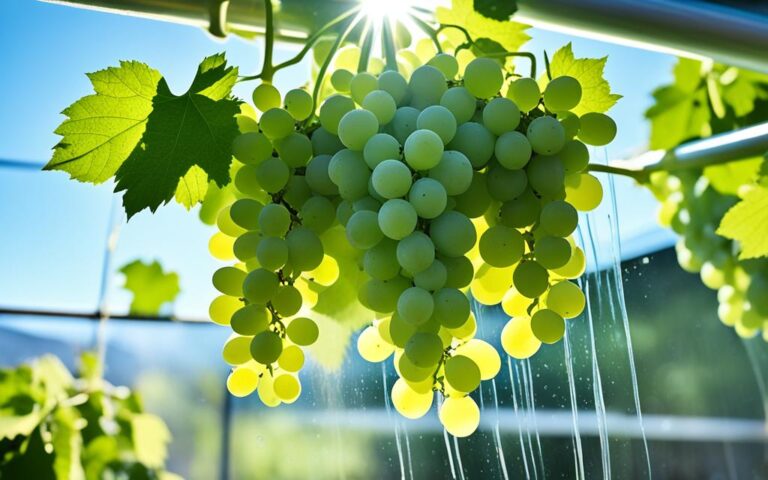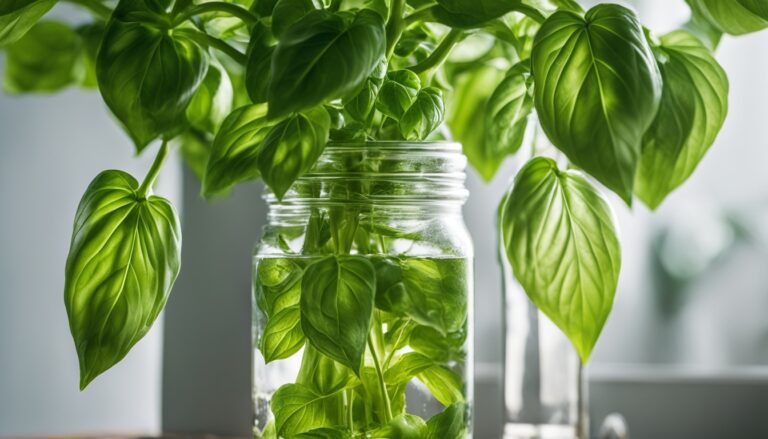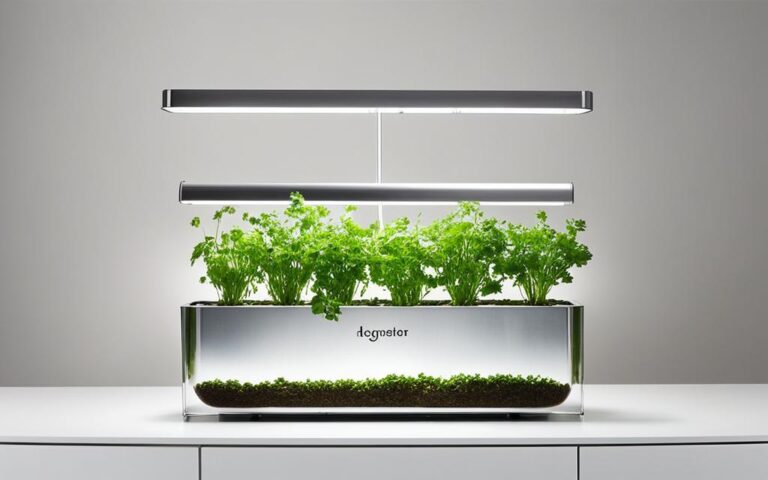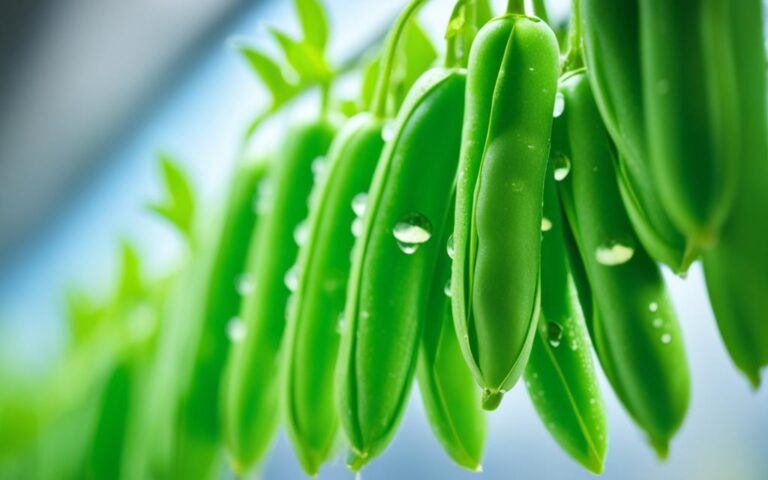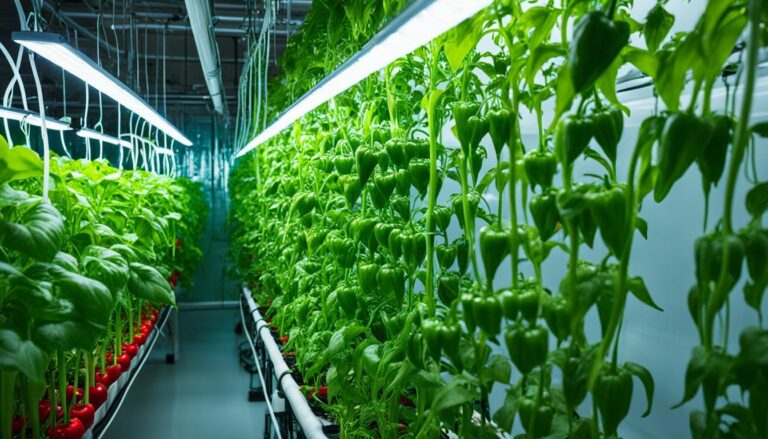Growing Hydroponic Fruits: A Modern Farming Guide
Today, we face big challenges with food security and the environment. Hydroponic farming is a new way to grow food that’s gaining attention. It’s a method where plants grow without soil. This guide will show you how to grow hydroponic fruits, covering setup, nutrients, and how to get the best yield and quality.
Key Takeaways
- Hydroponic systems can allow plants to grow up to 30% faster compared to traditional soil farming.
- Hydroponic systems can grow food in as little as 10% of the space required for soil farming.
- Hydroponic systems utilize significantly less water than traditional farming methods, contributing to water conservation efforts.
- Hydroponic systems offer better pest and disease control compared to traditional soil farming.
- Hydroponic systems enable year-round growing, allowing fresh produce cultivation regardless of the season.
Table of Contents
Introduction to Hydroponic Fruit Cultivation
Hydroponics is a new way to grow fruits without soil. It’s changing the game in fruit farming. This method is gaining fans among both big farms and backyard gardeners.
What is Hydroponics?
Hydroponics means growing plants in water, not soil. The plants’ roots get nutrients from a special water solution. This helps them grow strong and healthy.
Benefits of Growing Hydroponic Fruits
- Faster growth rates: Hydroponic plants grow quicker than those in soil. They get the nutrients they need right away.
- Higher yields: These systems can produce more fruit in less space. This makes them great for big farms.
- Water efficiency: Hydroponics uses up to 90% less water than traditional farming. It’s perfect for places where water is scarce.
- Year-round production: You can grow fruits all year with hydroponics. This means fresh produce is always available.
- Cultivation in limited spaces: You can even grow fruits in small areas, like in cities or tough climates.
Hydroponics lets farmers control things like nutrients, temperature, and light. This means plants grow better and produce more.
“Hydroponics could enable people in harsh environments with little water access to grow plant-based food.”
More people are choosing hydroponic fruit farming. It’s changing how we think about growing food today.
Selecting Hydroponic Fruit Varieties
Choosing the right best hydroponic fruit varieties is key to success. Hydroponics lets us grow many fruits, each needing its own special care. Popular ones include hydroponic strawberries, blueberries hydroponic, hydroponic raspberries, and blackberries hydroponic.
Berries do great in hydroponics, giving high yields with the right nutrients and conditions. It’s important to know what each variety needs for the best results.
Optimal Nutrient and Environmental Conditions
Choosing the right hydroponic fruits means knowing what they need. This includes things like:
- Electroconductivity (EC) ranges: EC levels can be from 0.8 to 5.0, depending on the fruit.
- pH levels: Most hydroponic plants like a pH between 5.0 and 7.5.
- Nutrient concentrations: Nutrient levels can vary from 500 to 3500 PPM.
Keeping these conditions right is key for healthy plants. It helps avoid problems like “tip burn” and makes the fruits taste better.
Matching Varieties to Your Hydroponic System
It’s also vital to pick fruits that fit your hydroponic setup. For example, hydroponic strawberries do well in certain systems. Make sure to check what each fruit likes and match it with your setup.
| Hydroponic Fruit Variety | Optimal Growing Conditions | Suitable Hydroponic Systems |
|---|---|---|
| Hydroponic Strawberries | EC: 1.0-2.0, pH: 5.5-6.5, Temp: 18-24°C | Nutrient Film Technique, Vertical Towers |
| Blueberries Hydroponic | EC: 0.8-1.2, pH: 4.5-5.5, Temp: 18-24°C | Ebb and Flow, Deep Water Culture |
| Hydroponic Raspberries | EC: 1.2-1.8, pH: 5.5-6.5, Temp: 18-24°C | Nutrient Film Technique, Aeroponics |
| Blackberries Hydroponic | EC: 1.4-2.0, pH: 5.5-6.5, Temp: 18-24°C | Ebb and Flow, Drip Irrigation |
By matching the fruit’s needs with the right hydroponic setup, growers can get the best growth and quality.

Setting up a Hydroponic System
Starting a hydroponic system for growing fruits needs careful planning. You should look at different system types and key parts. Common systems for home growers are deep water culture (DWC), nutrient film technique (NFT), and ebb and flow (flooding and draining). Each system has its own benefits and things to consider, like the grow medium (rockwool, coco coir, perlite) and supplemental lighting. Important parts include a water reservoir, grow tray, air pump, and a way to deliver nutrients to the roots.
Types of Hydroponic Systems
Hydroponic systems come in several types, each with special features and advantages:
- Deep Water Culture (DWC): This system lets the plant’s roots hang in a tank full of nutrients. It gives plants constant oxygen and nutrients for great growth.
- Nutrient Film Technique (NFT): Plants in this system get a steady flow of nutrient-rich water over their roots. It keeps them moist and fed well.
- Ebb and Flow (Flood and Drain): This method floods the grow tray with nutrients, then drains it. It copies nature’s watering cycle, giving roots oxygen and nutrients.
Essential Components of a Hydroponic Setup
Every hydroponic setup needs certain key parts for growing fruits well:
- Water Reservoir: Holds the nutrient-rich water that moves through the system.
- Grow Tray: Where plants sit, letting their roots get the nutrients they need.
- Air Pump: Adds oxygen to the water, helping roots grow strong.
- Grow Medium: Supports plants and keeps moisture and nutrients in place, like rockwool or coco coir.
- Lighting: LED grow lights are key for indoor setups to help plants grow well.
Picking the right hydroponic system and having these key parts ensures your fruits will grow well.
Nutrient Requirements for Hydroponic Fruits
Getting the nutrients right is key to growing fruits hydroponically. Plants need the right mix of nutrients like nitrogen, phosphorus, and potassium. It’s important to keep an eye on the hydroponic fruit pH, electrical conductivity (EC), and total dissolved solids (TDS) of the nutrient solution.
Essential Nutrients for Optimal Growth
During the fruiting stage, hydroponic plants need similar nutrients as they do in the flowering stage. Using a one-part solution like Dyna Gro “Bloom” or a three-part solution like General Hydroponics Flora Series is good. CALiMAGic is also a great choice to prevent issues like blossom end rot in plants like tomatoes and peppers.
Preparing Nutrient Solutions
Mixing the right amounts of fertilizers and minerals is key. This creates a nutrient-rich solution for the plants. The solution includes minerals from water and fertilizers. When picking fertilizer for hydroponic fruits, think about cost, availability, and purity.
| Nutrient | Concentration (ppm) |
|---|---|
| Nitrogen (N) | 150 |
| Calcium (Ca) | 90 |
| Phosphorus (P) | 60 |
| Potassium (K) | 150 |
| Magnesium (Mg) | 40 |
| Sulfur (S) | 50 |
| Iron (Fe) | 3 |
| Manganese (Mn) | 0.5 |
| Boron (B) | 0.5 |
| Copper (Cu) | 0.1 |
| Zinc (Zn) | 0.1 |
| Molybdenum (Mo) | 0.05 |
The table shows the Modified Sonneveld Solution Recipe for herbs. It’s a good starting point for hydroponic fruit nutrients during the fruiting stage. Adjust the amounts based on the fruit crop and growth stage.

Getting nutrients right is key to growing fruits hydroponically. By understanding the essential nutrients and preparing the solutions, growers can help their hydroponic fruit crops grow and thrive.
Environmental Factors for Hydroponic Fruits
Light and Temperature Requirements
Growing hydroponic fruits needs careful control of the environment. This includes enough light and the right temperature. For indoor or year-round growing, using hydroponic grow lights is key. LED and fluorescent lights are top choices because they save energy and work well.
These lights make sure plants get the right kind and amount of light. This helps them grow strong and produce good fruit.
Temperature is also very important for growing hydroponic fruits. Most fruits do best in a day temperature of 70-85°F and a night temperature of 60-70°F. Keeping the temperature just right helps plants grow well and produce top-quality fruit.
| Lighting | Temperature |
|---|---|
| LED and fluorescent grow lights are the most common and energy-efficient options Provide the appropriate spectrum and intensity to support healthy growth and fruit development Supplemental lighting is often necessary for indoor or year-round production | Optimal daytime temperature: 70-85°F Optimal nighttime temperature: 60-70°F Maintaining these temperature ranges is crucial for vigorous growth and high-quality fruit |
“Careful control of environmental factors, such as light and temperature, is essential for producing high-quality hydroponic fruits.”
By making sure plants get the right light for hydroponic fruits and the best temperature for hydroponic fruits, growers can make a great place for their fruits to grow. This helps with the health and productivity of the plants.
Planting and Maintenance
Starting hydroponic fruits can begin with hydroponic fruit seeds or hydroponic fruit transplants. Each method has its own benefits and things to consider. Using hydroponic fruit seeds lets growers control the growth from the start. But, it takes longer to see fruit. Transplanting seedlings or clones gives a quicker start and faster harvest.
Starting from Seeds or Transplants
When starting hydroponic fruits from seeds, pick high-quality, disease-free seeds. Follow the germination needs of the fruit type. This method lets growers watch the plants grow from the start. They can tailor care and nutrients. But, it takes more months to get to the fruit stage than with transplants.
Hydroponic fruit transplants offer an established root system and a growth boost. They come from trusted nurseries or are grown in-house. This method cuts down the time to harvest. Yet, growers have less control over the plant’s entire life.
Good care and maintenance are key for healthy, productive hydroponic fruit plants. This means checking on plant growth, adjusting nutrients, and keeping the hydroponic system clean and well-aired.

| Planting Method | Advantages | Disadvantages |
|---|---|---|
| Hydroponic Fruit Seeds | More control over the growth cycle Customized care and nutrient management | Longer time to reach fruiting stage |
| Hydroponic Fruit Transplants | Established root system and head start in growth Shorter time to harvest | Less control over the entire growth cycle |
“Hydroponic systems can use up to 10 times less water than traditional field crop watering methods.”
Pest and Disease Management
Growing hydroponic fruits faces challenges from pests and diseases. It’s important to watch closely and take action early to keep your system healthy. Pests like aphids, spider mites, and thrips can harm your crops. Diseases such as powdery mildew, root rot, and bacterial canker are also threats.
To fight these problems, use an integrated pest management (IPM) plan. This might mean using helpful insects, organic pesticides, and keeping your system clean and well-ventilated. Check your plants often, fix any nutrient issues, and make sure they grow in the best conditions to keep pests and diseases away.
Things like moisture, pH, electrical conductivity, and temperature affect pests and diseases in hydroponics. Keep an eye on these factors to make your system less welcoming to pests.
Using OMRI-approved products like bioenzymes and biostimulants can help manage pests and diseases. These products come from things like diatomaceous earth, Bacillus thuringiensis, and pyrethrins. They offer a natural way to fight pests without harsh chemicals.
Choosing the right plants and keeping them healthy is also crucial. Start with disease-free seedlings and clean your tools and soil. Growing plants that resist pests and keeping the environment right can help them fight off diseases on their own.
By taking a full approach to managing pests and diseases, hydroponic fruit growers can keep their crops healthy and productive. Staying up-to-date with the latest research and methods can help you overcome challenges and enjoy the benefits of growing hydroponic fruits.
Troubleshooting Common Issues
Keeping a hydroponic fruit garden healthy means always being on the lookout for problems. One big issue is nutrient deficiencies. These can show up as slow growth, color changes, or other signs. By watching the plants and testing the nutrient solution often, growers can spot and fix any imbalances fast. This makes sure their fruits grow well and taste great.
Identifying and Addressing Nutrient Deficiencies
Not getting enough nutrients can really hurt hydroponic fruit plants. Here are some common nutrient shortages and what they look like:
- Calcium deficiency: Causes tip burn and curling leaves
- Iron deficiency: Leads to interveinal chlorosis, with leaves appearing yellow between the veins
- Nitrogen deficiency: Results in stunted growth and yellowing of older leaves
- Phosphorus deficiency: Causes purple discoloration, especially on the undersides of leaves
To fix these hydroponic fruit problems, growers need to tweak the nutrient mix. Keeping an eye on the solution’s pH, which should be 5.5 to 6.5, helps too. This prevents nutrients from not being used and makes sure plants get what they need.
| Nutrient Deficiency | Symptoms | Corrective Action |
|---|---|---|
| Nitrogen (N) | Stunted growth, yellowing of older leaves | Increase nitrogen levels in the nutrient solution |
| Phosphorus (P) | Purple discoloration, especially on leaf undersides | Increase phosphorus levels in the nutrient solution |
| Calcium (Ca) | Tip burn, curling leaves | Increase calcium levels in the nutrient solution |
| Iron (Fe) | Interveinal chlorosis, leaves appear yellow between veins | Increase iron levels in the nutrient solution |
By staying ahead of hydroponic fruit nutrient issues, growers can make sure their plants get what they need. This leads to better growth and more fruit.
“Keeping a journal to track changes and results in hydroponic gardening is highly beneficial.”
Hydroponic Fruits for Commercial Production
Hydroponic farming is now big in the commercial world, especially for growing hydroponic fruits. Big hydroponic fruit farms use this method to get more produce, have crops all year, and use less resources. This helps meet the need for fresh, local fruits.
Big hydroponic fruit producers use new tech like automated systems and vertical farming. This helps them make more food in less space. These farms are key in giving people in cities and places with less resources access to healthy fruits.
Varieties Suitable for Commercial Hydroponic Production
Many fruits grow well in hydroponics, but some are best for big farms:
- Strawberries: Very popular for commercial hydroponic production, grown all year.
- Blueberries: Full of antioxidants, good for the brain and nerves, and has important vitamins.
- Tomatoes: Full of vitamins A, C, and folic acid, helps fight heart disease, diabetes, and cancer.
- Peppers: Loves warm weather and lots of light, includes Jalapeno and Habanero types.
- Cucumbers: Has iron, sodium, potassium, and vitamins B, C, and folic acid.
| Fruit Variety | Cultivation Time | Yield Potential | Nutrient Profile |
|---|---|---|---|
| Strawberries | Year-round | High | High in antioxidants and vitamin C |
| Blueberries | 2-3 months | Moderate | High in antioxidants, vitamins, and minerals |
| Tomatoes | 2-3 months | High | Rich in vitamins A, C, and folic acid |
| Peppers | 2-3 months | Moderate to High | Low in calories, high in vitamins and nutrients |
| Cucumbers | 6-8 weeks | High | Contains micro-elements and vitamins |
These fruits are great for commercial hydroponic production and are very nutritious. They are perfect for people who want fresh, healthy food.
“Hydroponic farming has changed how we grow commercial fruits. It lets us grow many crops year-round and efficiently.”
By using hydroponics, commercial hydroponic fruit growers can give people nutritious, eco-friendly fruits. This helps make our food system better and more fair.
Tips for Maximizing Yield and Quality
To get the best hydroponic fruit yield and improve hydroponic fruit quality, you need a detailed plan. As a grower, using techniques for high-yield hydroponic fruits can help you get the most from your setup.
Getting the nutrients right is key to a great yield and quality. Make sure to check and adjust the pH, EC, and water temperature often. This ensures your plants get what they need for strong growth and lots of fruit.
Also, having the right environment is vital. The right lighting, good air circulation, and pest management help your fruits grow well and taste great.
Using advanced growing methods like vertical farming or multi-tiered systems can boost your yield. These methods use space well and let you grow more plants in less space, making more fruit.
Keep an eye on things like pH, EC, and water temperature. Making adjustments as needed keeps your plants in the best spot for growth. This way, your hydroponic fruits can reach their best quality.
“Hydroponic farming can amplify the benefits of traditional agriculture by leveraging vertical space, increasing planting density, and maximizing productivity.”
With these techniques for high-yield hydroponic fruits, growers can make the most of their systems. They can produce high-quality, flavorful fruits that people want and the market needs.
Advantages and Disadvantages of Hydroponic Farming
Hydroponic farming is a new way to grow plants without soil. It has many benefits but also some drawbacks to think about.
Advantages of Hydroponic Farming
- Increased Productivity: Hydroponic systems grow more plants and make them grow faster. This means more food from the same space.
- Water Efficiency: Hydroponics uses up to 90% less water than traditional farming. This is great for areas with little water.
- Year-Round Cultivation: You can grow crops all year, not just in certain seasons. This means food is always available.
- Controlled Environment: Growers can control things like nutrients, temperature, and light. This helps plants grow better and stay healthy.
- Reduced Pest Pressure: Without soil, pests and weeds don’t thrive. This means less need for harmful chemicals.
- Compact Footprint: Hydroponics works well in small spaces. It’s perfect for cities and places where farming is hard.
Challenges of Hydroponic Farming
- Higher Upfront Costs: Starting a hydroponic farm costs more than traditional farming, especially for big farms.
- Energy Demands: Hydroponics needs a lot of electricity for pumps, lights, and climate control. This can be expensive.
- Nutrient Density Concerns: Some studies question if hydroponic plants are as nutritious as soil-grown ones.
- Organic Certification Challenges: There’s a debate over if hydroponic produce can be organic. The USDA rules were made for soil farming.
- Technical Expertise: Hydroponic farming needs a lot of knowledge to work well and grow healthy plants.
- Vulnerability to Power Outages: Hydroponic farms can fail if there’s a power outage. This could mean losing all your crops.
Hydroponic farming has many benefits, like being sustainable and secure for food. But, it’s expensive to start and uses a lot of energy. There are also debates about its nutrient content and organic status. As it grows, finding the right balance between its good and bad points will be key to its success.
“Hydroponic farming is a game-changer in the world of agriculture, offering a sustainable and efficient solution to some of the most pressing challenges we face in food production.”
Sustainability and Environmental Impact
Hydroponic farming is a big step forward for the environment. It uses up to 90% less water than traditional farming. This makes it very efficient with water. Plus, many hydroponic systems recycle their water, saving even more.
Hydroponics also cuts down on harmful chemicals. It doesn’t need pesticides or herbicides. Hydroponic systems can cut carbon emissions by 70-90% compared to traditional farming. This is great for fighting climate change.
Also, hydroponics lets crops grow all year and in small spaces. This means less transportation and a smaller carbon footprint. Vertical hydroponics can produce 10 times more crops per area than traditional farming. This makes it very efficient and sustainable.
But, hydroponics does use a lot of energy for lights and climate control. Using renewable energy can make it better for the planet. This makes hydroponic fruit farming a key part of eco-friendly farming.
“Hydroponic farming significantly eliminates the need for chemical fertilizers and pesticides, dramatically reducing the ecological impact of food production.”
We’re facing big environmental issues like soil erosion, water scarcity, and climate change. Hydroponic farming is a good answer. It helps us make a more sustainable food system. We can have plenty of food without hurting the planet.
| Metric | Traditional Farming | Hydroponic Farming |
|---|---|---|
| Water Usage | High | Up to 90% less |
| Pesticide/Herbicide Use | High | Significantly reduced |
| Carbon Emissions | High | Up to 90% less |
| Land Usage | High | Compact, vertical systems yield more per unit area |
Conclusion
Hydroponic fruit cultivation is a modern way of farming that brings many benefits. It uses water instead of soil and helps plants grow faster and produce more. This method is great for growing fruits all year, even in tough places or small spaces.
This guide has covered the basics of hydroponic fruit growing. We talked about setting up the system, managing nutrients, controlling the environment, and growing on a large scale. It’s clear that hydroponic farming is key to meeting our food needs in a green way.
As more people want food that’s good for the planet, hydroponic farming is becoming more important. Whether you’re a big farmer or just growing fruits at home, the future looks bright. With new tech and more people wanting hydroponic fruits, the outlook is good for both home and commercial growers.
The world needs more sustainable food sources as the population grows. Hydroponic farming is stepping up to the challenge. By using this method, farmers and buyers can enjoy healthier food and help the planet. This way, we can have a better food system for the future.


